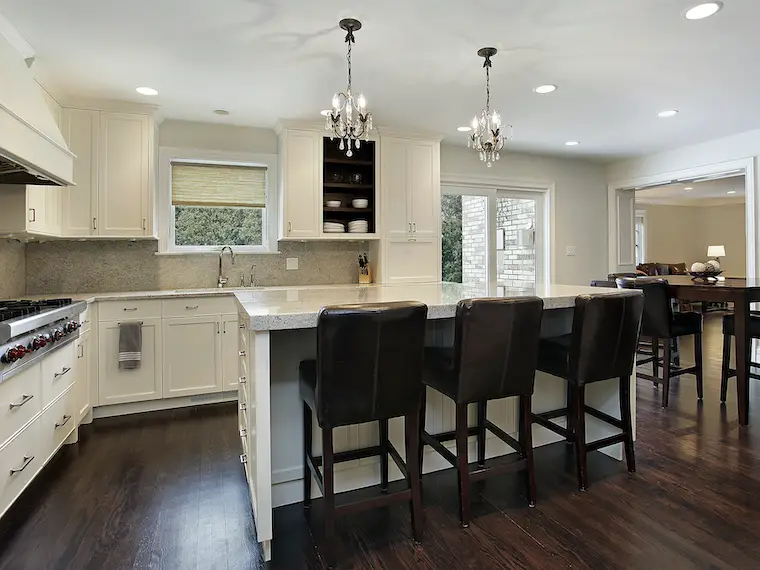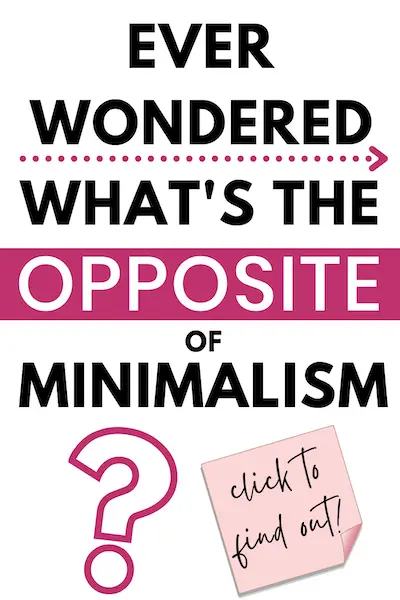Before we get into what is the opposite of minimalism, let’s quickly go over the definition of minimalism first, so we’re on the same page.
“Minimalism is simply about stripping away the unnecessary things in your life so you can focus on what’s important”
Joshua Fields Millburn, Minimalism: Live a Meaningful Life
This page contains affiliate links which means I may earn a commission if you use them, at no additional cost to you. See disclosure policy for details.
What is the opposite of minimalism?
If minimalism is about focusing only on what’s important, the opposite of minimalism would be to focus on unnecessary details.
Remember that minimalism is both a design aesthetic and a lifestyle. One can live like a minimalist, simplifying their life and possessions, without a minimalist designed space.
The opposite of a minimalist lifestyle is living unintentionally.
The opposite of minimalist design is maximalism.
I’m going to go into more detail about each of these so you can understand the subtle differences in each.
The opposite of minimalist lifestyle is being unintentional
Minimalist living is about intentionally creating your best life. It’s about simplifying and focusing on what matters most to you. Choices are made based on careful thought and consideration.
Intentional living is the very foundation of minimalist living.
Read more about it here.
A non-minimalist may be living life unintentionally. What that means is they make decisions impulsively or based on what others suggest for them. They go along with the status quo without thinking if that lifestyle is what they actually want (aka keeping up with the Joneses).
Here are some examples:
Shopping
The minimalist needs simple and will only make thoughtful, intentional purchases. Minimalists don’t buy things just because it is pretty or on sale. They take time to think about what they need and consider if this purchase will meet their need or not.
It’s important for them to be mindful when shopping in order to maintain a peaceful flow in their space. The minimalist cares more about a zen like atmosphere and will make sure that they maintain that.
Making intentional purchases helps prevent having a cluttered home. It also helps a lot with staying on budget!
A minimalist opposite (AKA a non-minimalist) prefers spontaneous, fun purchases. They see, they like they buy. Spending impulsively or unintentionally often leads to overspending and having a cluttered home!
Kitchen
So how does intentionality tie in with minimalism in terms of functionality in the kitchen?
In a minimalist kitchen, every object is chosen intentionally. Everything will have its place and will be easy to find and use, enabling the kitchen to run smoothly!
In typical kitchens, you’ll find a jumbled assortment of Tupperware, duplicate cooking utensils and multiple kitchen gadgets that only have one use.
Read more about minimalist kitchen design & organization and get the minimalist kitchen checklist.
Despite minimalism being about living intentionally, someone could still be intentional without being a minimalist. For example, there are people who truly get joy out of having a lot of stuff.
If they have intentionally chosen to keep the stuff they do have because it makes them feel good, then they would not be a minimalist even though they are living intentionally. More specifically, they are practicing intentional maximalism in their design choices.
The opposite of minimalist design is maximalist design
Let’s have a look at the different philosophies between minimalism and maximalism in order to better understand what makes them so opposite to each other.
Maximalism design aesthetic is about having a bold style, loud patterns and a visually engaging space. Think: Bohemian, baroque or eclectic styles. A visually appealing maximalist space is bold and demands attention.
The maximalist strives to achieve beauty, boldness and attention in their space. They look for and anticipate the wow factor when visitors arrive and prefer to fill spaces with lots of detail.
Opposite to that, minimalist design likes simple, neat, clean lines, subdued color palette. A visually appealing minimalist space is calming to the senses.


The minimalist takes a more zen like approach to their living space; enhancing mental peace and stability.
Because minimalists appreciate an aesthetically subdued space, they tend not to decorate with loud colors or bold objects. They’re interested in helping guests feeling calm, relaxed and peaceful in their space.
Both minimalists and maximalists put great thought into their living space, they simply enjoy different things!
A small example of this would be:
-a minimalist most likely would opt to purchase a simple white vase with subtle colours for their living room while the maximalist will scoop up the big bold and bright vase.
It’s somewhat easy for the minimalist to intentionally pick out and purchase something small and simple knowing that the flowers inside the vase will be the showstoppers. The maximalist, however, will gravitate towards bright and loud to go for maximum impact.
The opposite of a minimalist is a maximalist
Are you a borderline maximalist?
That’s totally possible (and ok!). As long as you are living intentionally in a way that brings you joy, you’re doing great!
Neither minimalism nor maximalism are better than the other, they’re just different options. Intentionally choose which is right for you and own it!


